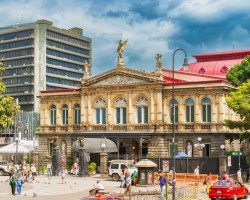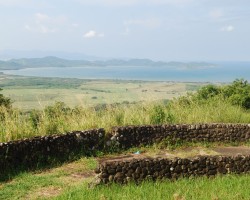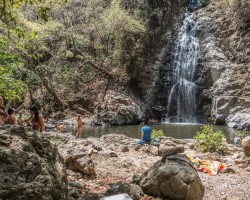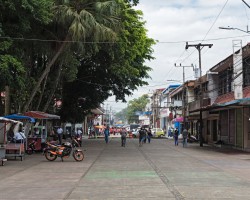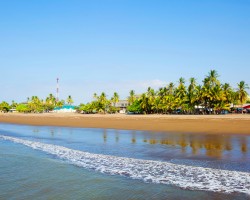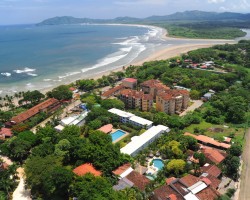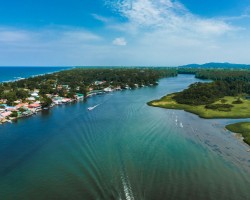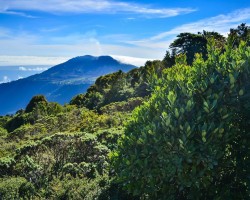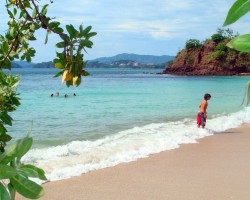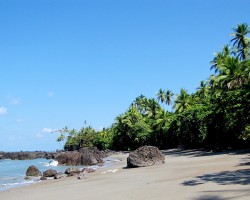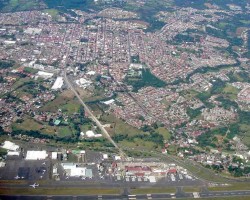Best time to go to Costa Rica for a perfect weather and where to go?
When is the best time to go to Costa Rica?
The climate of Costa Rica is hot all year round. The weather is often favorable for traveling. However, the best time to visit Costa Rica is between December and April. This is the dry season, and beautiful sunny days are plentiful throughout the country.
To enjoy the best possible weather conditions, it is advisable to prefer the months of January, February, and March, which are particularly favorable. Indeed, the heat is present, and precipitation is low. During this period, you will also find important cultural events that will enhance your stay.
Nevertheless, the rainy season is not necessarily to be avoided. Some regions of Costa Rica remain suitable for tourist visits. This is the case of the Pacific coast, which is less affected by rainfall. Those who choose to travel to Costa Rica during this period will also be able to take advantage of advantageous offers while enjoying a relatively pleasant climate.
Furthermore, during this period, there is common wind on the Pacific coasts. This creates strong waves that provide ideal conditions for surfing.
Finally, if you are wondering when to visit Costa Rica to discover the local culture, know that the entire year is marked by religious festivities. They take place in different cities of the country such as in San José on March 19, but the most famous one is Semana Santa during the months of March-April. These events, rich in sharing and conviviality, will allow you to easily mingle with the locals.
Where and when to go based on the weather?
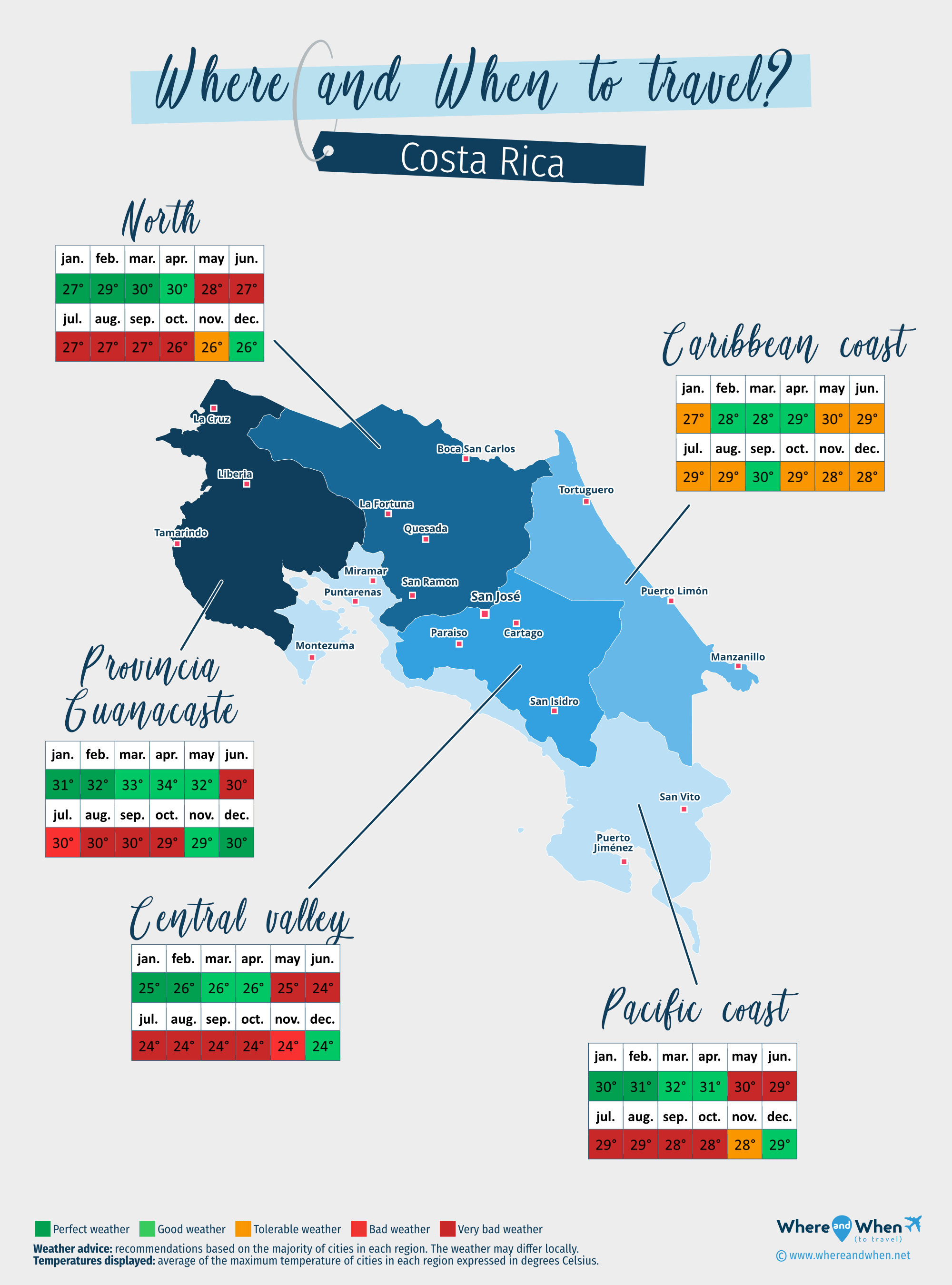
Caribbean coast of Costa Rica
Tortuguero, Puerto Limón, Manzanillo...
Central valley
San Jose, San Isidro, Cartago...
North of Costa Rica
La Fortuna, Quesada, Boca San Carlos...
Pacific coast of Costa Rica
Montezuma, Puntarenas, Puerto Jiménez...
Provincia Guanacaste
La Cruz, Tamarindo, Liberia (Guanacaste)...
To get all the information about the climate and weather in Costa Rica for a specific month, click on the corresponding link below:
Costa Rica in january Costa Rica in february Costa Rica in march Costa Rica in april Costa Rica in may Costa Rica in june Costa Rica in july Costa Rica in august Costa Rica in september Costa Rica in october Costa Rica in november Costa Rica in december
Best time to travel to Costa Rica by cities
Climate and Weather in Costa Rica
Located in the heart of Central America, between Panama and Nicaragua, Costa Rica experiences a wide variety of climates depending on the regions. Thus, there is a climate that is sometimes humid tropical, sometimes equatorial, but also a temperate zone in the center of the country. Like any tropical area, there are however two seasons in Costa Rica:
- a dry season, between December and April
- a rainy season, known as the "green season", which extends from May to November
The months of March and April, which mark the transition to the rainy season, are the hottest with temperatures reaching up to 36°C. Nevertheless, due to its location near the Equator, temperature variations are small in Costa Rica throughout the year.
In general, the dry season is also the coolest with temperatures ranging from 14 to 30°C (86°F) . The rainy season, on the other hand, is warmer with temperatures ranging from 18 to 36°C (97°F) . Of course, this varies depending on the locations.
Therefore, it is more the rainfall that determines the different seasons in Costa Rica. However, the various regions are affected unevenly.
Although the rainy season may scare travelers, it is worth noting that it rarely rains all day in Costa Rica. There are "aguaceros": heavy showers that usually stop within 1 or 2 hours. They mostly fall in the afternoon, leaving the opportunity to enjoy sunny mornings.
Finally, Costa Rica is not really affected by hurricanes from the Caribbean Sea as they often pass further north. However, the country was hit in November 2016 by Hurricane Otto and in October 2017 by Hurricane Nate. The damages were significant. This is why the hurricane season, which extends from June to November, and more specifically between September and November, should be avoided for a trip. Especially if you plan to visit the northern Caribbean coast.
Let's take a closer look at the climate of Costa Rica, region by region, to help you prepare for your trip.

Climate of Costa Rica on the Caribbean coast
The climate on the eastern coast bordered by the Caribbean Sea is of equatorial type. Thus, there is no marked difference between the wet and dry seasons. Precipitations are very frequent throughout the year. For example, there are 3500 mm of rainfall per year in Puerto Limón.
Moreover, it is very hot most of the time and there is humidity that is difficult to bear, especially during the rainy season. The sun shines quite rarely and cloudy days are numerous in this area.
As a result, this region is not very touristy.
Climate of Costa Rica - Central Valley
In the heart of the country, in the area called the "Central Valley," Costa Rica experiences a more temperate climate than on the coasts. Especially around San José, temperatures are relatively mild throughout the year, with cool nights and constant warmth, without being stifling. The mercury rarely drops below 14°C (58°F) and reaches a maximum of around 27°C (81°F) . The sun is also widely present during the dry season. For all these reasons, it is often said that the Central Valley enjoys an eternal spring!
Moreover, even if the humidity is less pronounced in this part of Costa Rica than in the rest of the country, it must be said that precipitations are significant during the wet season. There are 20 rainy days or more between June and October. The months of September and October are indeed the rainiest in the capital with 300 mm of precipitation.
On the other hand, the mountains are, in turn, nicknamed the "tierras frias". Indeed, temperatures can drop significantly in this area with strong differences between day and night.
Climate of Costa Rica on the Pacific coast
The climate of Costa Rica on the Pacific coast is generally tropical. There is a well-defined dry season between November and April. The heat can be intense during this period, but thanks to the northeast trade winds, the humidity is less felt. In fact, the Nicoya Peninsula is the region with the least rainfall compared to the rest of the country. For example, there is less than 50 mm of precipitation between December and March in Puntarenas.
However, between May and October, the weather in Costa Rica in this region is characterized by intense rains and a often overcast sky.
On the other hand, in the south of the Pacific coast, the climate becomes rather equatorial with possible rains all year round. Indeed, the area of Corcovado National Park, with its tropical jungles, is, as you can imagine, very rainy.
Temperatures and rainfall in Costa Rica
On these 3 graphs, we present the evolution of temperatures of Costa Rica and month-by-month rainfall for the cities of San José, La Cruz, Montezuma, Puerto Limón and Puntarenas, as well as the month-by-month sea temperature for coastal cities.
Peak visitor numbers and tourist seasons in Costa Rica
Find out when Costa Rica has its high tourist season (the period when the influx of tourists is highest) and off-peak tourist season using our data and figures.
Tourist seasons in Costa Rica
The months with low numbers of tourists are: April, May, June, July, September, October and November. The number of visitors to Costa Rica is high in: January, February, March, August and December.
- Very low season in Costa Rica: May, June, September and October.
- Low season in Costa Rica: April, July and November.
- High season in Costa Rica: January, February, March and August.
- Peak season in Costa Rica: December.
Figure: Visitor index for Costa Rica month by month
Average price for flights to Costa Rica
A return flight between New York City and San José is generally cheaper if you go in october ($ 378 on average): this is the best time for travellers on a tight budget. In contrast, you may end up paying $ 308 more for your airline ticket to San José if you go in december.
Find the best price for your flight Flight prices to Costa Rica
Where to go in Costa Rica?
This table allows you to see the maximum temperature for each city and our opinion on the weather month by month (see colour legend below the table).
| Cities | jan. | feb. | mar. | apr. | may | jun. | jul. | aug. | sep. | oct. | nov. | dec. |
| San José | 77°F | 79°F | 81°F | 81°F | 79°F | 77°F | 76°F | 77°F | 77°F | 76°F | 76°F | 76°F |
| La Cruz | 86°F | 86°F | 88°F | 90°F | 90°F | 88°F | 86°F | 88°F | 88°F | 86°F | 86°F | 86°F |
| Montezuma | 88°F | 90°F | 92°F | 92°F | 88°F | 86°F | 86°F | 86°F | 86°F | 85°F | 85°F | 86°F |
| Puerto Limón | 83°F | 85°F | 85°F | 86°F | 86°F | 86°F | 86°F | 86°F | 88°F | 86°F | 85°F | 85°F |
| Puntarenas | 90°F | 94°F | 94°F | 94°F | 90°F | 88°F | 88°F | 88°F | 88°F | 86°F | 86°F | 88°F |
| Tamarindo | 88°F | 90°F | 92°F | 94°F | 90°F | 88°F | 86°F | 86°F | 86°F | 85°F | 85°F | 86°F |
| Tortuguero | 83°F | 85°F | 85°F | 86°F | 88°F | 86°F | 86°F | 86°F | 88°F | 88°F | 85°F | 83°F |
| Boca San Carlos | 81°F | 83°F | 86°F | 88°F | 88°F | 85°F | 83°F | 85°F | 86°F | 85°F | 83°F | 81°F |
| Cartago | 76°F | 77°F | 77°F | 77°F | 76°F | 74°F | 74°F | 74°F | 74°F | 74°F | 74°F | 74°F |
| La Fortuna | 81°F | 83°F | 86°F | 88°F | 88°F | 85°F | 83°F | 85°F | 86°F | 85°F | 83°F | 81°F |
| Liberia (Guanacaste) | 88°F | 92°F | 94°F | 95°F | 92°F | 88°F | 88°F | 88°F | 88°F | 86°F | 86°F | 86°F |
| Manzanillo | 81°F | 83°F | 83°F | 85°F | 86°F | 86°F | 86°F | 86°F | 86°F | 86°F | 85°F | 83°F |
| Puerto Jiménez | 88°F | 90°F | 90°F | 90°F | 86°F | 85°F | 85°F | 85°F | 85°F | 83°F | 83°F | 85°F |
| Quesada | 83°F | 86°F | 88°F | 86°F | 83°F | 81°F | 81°F | 81°F | 81°F | 79°F | 79°F | 81°F |
| San Isidro | 83°F | 85°F | 85°F | 83°F | 79°F | 79°F | 79°F | 79°F | 77°F | 77°F | 77°F | 79°F |
| Alajuela | 81°F | 83°F | 85°F | 85°F | 81°F | 79°F | 79°F | 79°F | 79°F | 77°F | 77°F | 79°F |
| Bananito Sur | 83°F | 85°F | 85°F | 86°F | 86°F | 86°F | 86°F | 86°F | 88°F | 86°F | 85°F | 85°F |
| Cerro Chirripo | 83°F | 85°F | 85°F | 83°F | 79°F | 79°F | 79°F | 79°F | 77°F | 77°F | 77°F | 79°F |
| Dominical | 83°F | 85°F | 85°F | 83°F | 79°F | 79°F | 79°F | 79°F | 77°F | 77°F | 77°F | 79°F |
| Escazu | 77°F | 79°F | 81°F | 81°F | 79°F | 77°F | 76°F | 77°F | 77°F | 76°F | 76°F | 76°F |
Legend:
perfect weather
good weather
tolerable weather
bad weather
very bad weather
About Costa Rica
What can I do in Costa Rica?
Beaches / swimming
Nature and countryside
Culture and heritage
Sports
Family travel
Crafts / shopping
Gastronomy
Nightlife
Is this weather information for Costa Rica reliable?
Climate data for Costa Rica has been gathered every day since January 2009. The analysis of these meteorological data for Costa Rica allows us to determine the average for each month in San José, La Cruz, Montezuma, Puerto Limón, Puntarenas, Tamarindo, Tortuguero, Boca San Carlos, and 76 other cities.
So yes: this data is reliable except in cases of temporary climate disruption in the region.

